To guarantee consistency in your designs, you should utilize a structured typography scale that defines clear size relationships between headings, subheadings, and body text. This creates a harmonious visual hierarchy, makes content easier to scan, and reinforces your brand identity across different platforms. Using tools like scale generators or style guides can help you maintain uniformity. Keep exploring how these strategies can transform your work and elevate your overall design approach.
Key Takeaways
- Establish a clear primary scale to define size relationships between headings, subheadings, and body text.
- Use consistent font pairings and spacing guided by the chosen typography scale across all platforms.
- Incorporate tools like type scale generators and style guides to maintain uniformity.
- Regularly review and update your typography rules to adapt to evolving design needs.
- Apply proportional ratios, such as Fibonacci or golden ratio, to ensure harmonious and cohesive font size relationships.
Understanding the Basics of Typography Scales
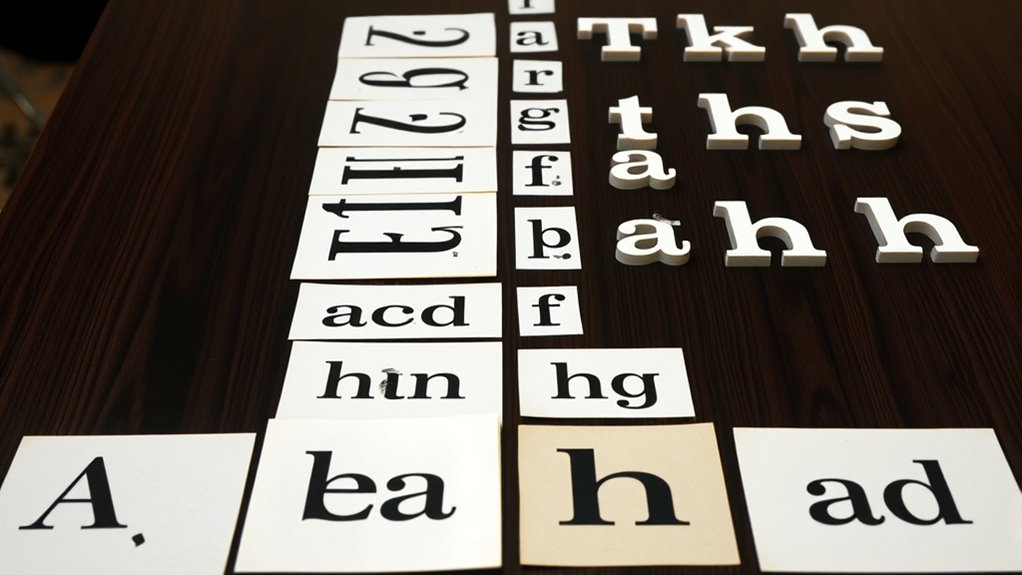
Have you ever wondered how designers create a harmonious and consistent look across a website or app? It all starts with understanding typography scales. These scales help you establish a clear hierarchy by assigning different sizes to headings, subheadings, and body text. When you use a well-structured typography scale, it simplifies font pairing, ensuring your fonts complement each other without clashing. Additionally, it aids readability optimization by maintaining consistent spacing and size relationships. This consistency guides users smoothly through your content, making it easier to scan and understand. By mastering the basics of typography scales, you set a solid foundation for a visually appealing and user-friendly design. It’s the key to creating a cohesive look that enhances both style and functionality. Smart design principles emphasize creating comfortable, welcoming living spaces that are both beautiful and practical. Moreover, understanding how typography scales influence visual harmony allows designers to craft interfaces that are not only attractive but also highly functional. Recognizing the importance of visual hierarchy helps in organizing information effectively and guiding user attention appropriately. A well-planned typography scale also enhances the overall brand consistency, ensuring your visual identity remains uniform across various platforms. Incorporating personality traits into your design choices can further strengthen user engagement and brand perception.
Types of Typography Scales and Their Applications

You’ll find that classic modular scales use predefined ratios to create harmony across your typography, making your design feel consistent and balanced. Fluid and responsive scales adapt to different screen sizes, ensuring your text remains readable and visually appealing on any device. Choosing the right type depends on your project’s needs and how you want your typography to behave across various contexts. Incorporating typography scales can also help emphasize certain content, such as highlighting health benefits or key concepts effectively. Additionally, understanding auditory processing can inform how you structure content to improve comprehension and engagement. Using page navigation effectively can guide users through your content smoothly and enhance overall readability. Utilizing text hierarchy with well-chosen scales can further enhance clarity and guide readers through complex information smoothly.
Classic Modular Scales
Classic modular scales are a foundational tool in typography, helping you create harmonious and consistent visual hierarchies. These scales draw from historical typography, where designers relied on mathematical ratios like the perfect fifth or golden ratio to structure type. By using a set of predefined ratios, you can establish a rhythm that guides font pairing and size relationships across your design. Classic scales, such as the Fibonacci or the musical interval-based scales, provide a reliable framework for balancing proportions and ensuring readability. When applied thoughtfully, they help maintain visual harmony, making your typography more cohesive. Understanding these scales allows you to develop a structured approach that enhances the overall clarity and aesthetic appeal of your project. Additionally, incorporating mathematical ratios into your scale selection can further improve the consistency and visual appeal of your typography.
Fluid and Responsive
Fluid and responsive typography scales adapt seamlessly to various screen sizes and devices, ensuring your text remains legible and visually balanced. This approach supports adaptive typography by adjusting font sizes dynamically, creating a flexible design that enhances user experience across platforms. Imagine:
- Text that scales down smoothly on a smartphone, maintaining readability without clutter.
- Headlines that grow proportionally on larger screens, commanding attention without overpowering.
- Body copy that retains clarity and harmony, whether viewed on a tablet or desktop.
- Incorporating typography scales ensures consistent visual hierarchy and readability across all devices. Additionally, integrating AI security principles can help protect sensitive content displayed across different platforms, maintaining integrity and confidentiality. Recognizing the importance of contrast ratio can further optimize readability and visual impact, especially on varying screen types and lighting conditions. Understanding regional legal resources can also inform how your content adapts to diverse audiences and jurisdictions. Recognizing the influence of spiritual energy can inspire more mindful and harmonious design choices that resonate with users on a deeper level.
Choosing the Right Scale for Your Project
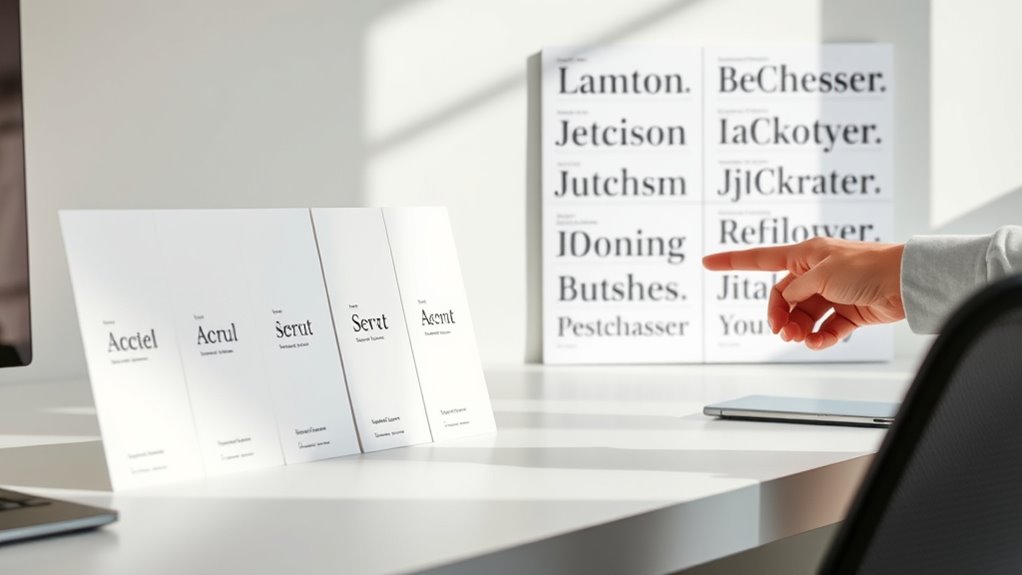
Choosing the right scale for your project is essential to create a cohesive and visually appealing typographic hierarchy. First, consider your overall design goals and the message you want to communicate. Select a scale that supports effective font pairing, ensuring your typefaces complement each other without clashing. A well-chosen scale also enhances color harmony, making your design more unified and easier to read. Think about the context—digital or print—and how your typography will adapt across devices or mediums. Avoid overly complex scales, as they can confuse viewers. Instead, opt for a simple, consistent system that guides the eye smoothly through your content. By carefully selecting a scale aligned with your project’s tone and visual style, you set a strong foundation for a balanced and engaging design. Incorporating a typography scale can further help maintain visual consistency across different elements.
Establishing a Visual Hierarchy With Scales

Using scales helps you differentiate content levels clearly, making it easier for readers to scan your work. When you establish a hierarchy, you guide their focus to what’s most important first. This guarantees your message is communicated effectively and effortlessly. Additionally, understanding the community-driven nature of fan trailers can help you tailor your visual hierarchy to resonate with engaged audiences. Recognizing the importance of visual consistency in your design ensures a cohesive and professional appearance across all elements. Incorporating essential oil benefits can further enhance the clarity of your content by highlighting specific health advantages associated with each oil. Being aware of design principles rooted in color theory and typography can reinforce the effectiveness of your scale choices.
Differentiating Content Levels
How can you clearly indicate different content levels within your design? Using a thoughtfully crafted typography scale helps establish a strong visual hierarchy. To create this, consider these imagery cues: 1. A bold, large headline that commands attention like a mountain towering over valleys. 2. Subheadings with a slightly smaller font, acting as bridges linking sections. 3. Body text, simple and clear, flows seamlessly like a gentle stream. 4. Incorporate elements such as vintage decor and rustic accents to enhance the thematic consistency across content levels. Additionally, understanding typography hierarchy ensures that each element communicates its importance effectively, guiding the viewer through the content effortlessly. Recognizing the importance of interior design basics can further inform your approach to content organization and visual clarity. When designing for zoning laws, clear typographic differentiation helps clarify complex regulations and legal distinctions. Moreover, employing consistent font choices across levels reinforces the visual structure and improves overall readability.
Guiding Reader Focus
A well-designed typography scale directs your readers’ attention exactly where you want it. By establishing a clear visual hierarchy, you create natural cues that guide their focus through your content. Larger, bolder text emphasizes key headlines or calls to action, increasing visual emphasis and making important information stand out. Smaller type levels help assign secondary importance, allowing readers to scan smoothly without losing interest. Consistent scaling ensures that each element maintains its purpose, boosting reader engagement by making the content easier to navigate. When your typography scale aligns with your content’s hierarchy, you help your audience quickly grasp the structure and key messages. Employing passive voice detection tools can further enhance clarity by highlighting areas where active voice can improve the flow. This intentional visual emphasis keeps readers engaged and ensures your content’s flow remains clear and compelling.
Implementing Scales in Digital and Print Design

Have you ever wondered how to guarantee your typography remains consistent across both digital screens and print materials? Implementing scales helps establish a clear typography hierarchy, ensuring your content is easily navigable. To do this effectively, you should:
Ensuring consistent typography across screens and print relies on well-structured scales and harmonious font pairing.
- Choose a primary scale that defines the size relationships between headings and body text.
- Apply consistent font pairing to create visual harmony across mediums.
- Adjust scales subtly for digital screens versus print, maintaining proportional relationships.
Using a well-structured typography scale ensures your fonts work seamlessly in both contexts, preserving hierarchy and readability. Font pairing becomes even more impactful when scales are aligned, making conversions between digital and print smooth and visually cohesive. This approach guarantees your message stays clear and professional regardless of medium.
Common Mistakes to Avoid When Using Typography Scales

While implementing typography scales can greatly improve your design consistency, many designers stumble by making common mistakes that undermine their efforts. One mistake is neglecting proper font pairing, which can create visual disharmony. Avoid using unrelated fonts that clash or distract. Also, resist the urge to customize scales excessively; scale customization should enhance readability, not complicate it. Over-customization can lead to inconsistent typography. Additionally, rigidly sticking to a fixed scale without considering context can hinder flexibility. To prevent these issues, review your scale regularly and adjust only when necessary. Here’s a quick overview:
| Mistakes to Avoid | Tips for Success |
|---|---|
| Poor font pairing | Select complementary fonts |
| Excessive scale customization | Keep adjustments minimal |
| Ignoring context | Adapt scale as needed |
Tools and Resources for Creating Effective Scales
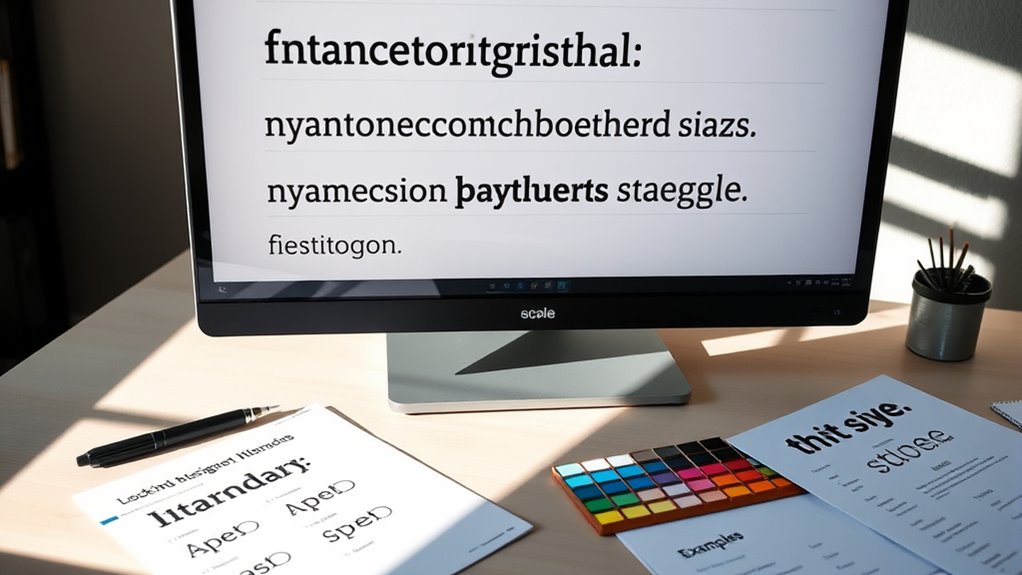
Creating effective typography scales is easier when you leverage the right tools and resources. These help you establish harmony in font pairing and ensure ideal color contrast.
Imagine using:
- Type Scale Generators – visualize a tool that automatically suggests harmonious font sizes, making your typography consistent across projects.
- Color Contrast Checkers – picture an app that instantly verifies your color contrast, ensuring accessibility and readability.
- Font Pairing Libraries – think of curated collections that inspire you, showing how different fonts complement each other within a cohesive scale.
These resources streamline your process, giving you confidence that your typography remains visually consistent and accessible. Incorporating them helps you craft scales that are both functional and aesthetically pleasing.
Case Studies: Successful Use of Typography Scales
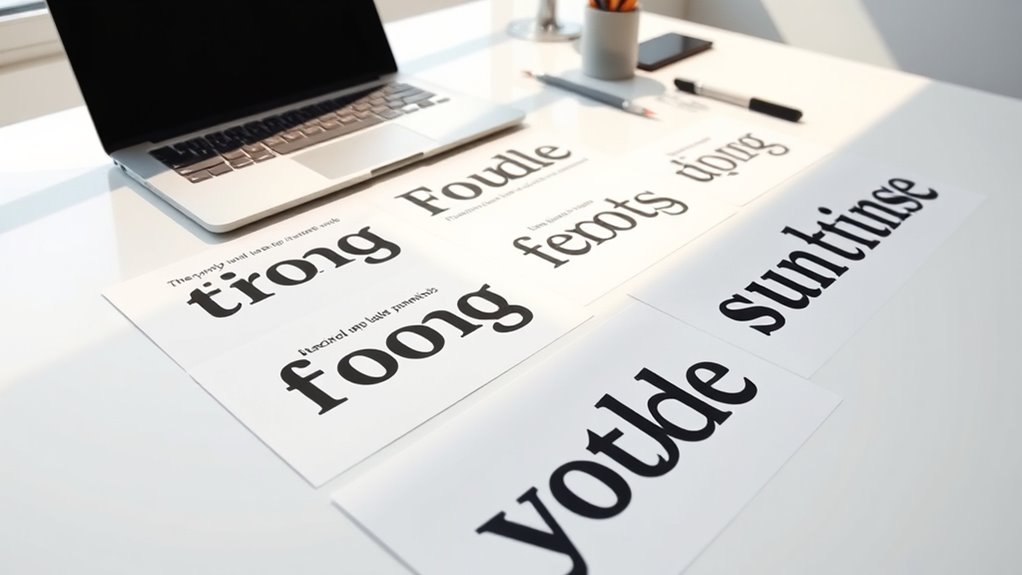
You’ll see how effective typography scales can boost brand recognition by creating a consistent look across platforms. They also improve visual hierarchy, making content easier to scan and understand. These case studies highlight real-world success stories that demonstrate the power of thoughtful typography.
Brand Recognition Enhancement
Have you ever wondered how some brands achieve instant recognition through their typography choices? They masterfully use typography psychology and font pairing to create memorable identities. For example, imagine:
- A bold logo font that conveys strength and reliability.
- Consistent headline and body fonts that reinforce brand personality.
- Unique typography scales that make key messages stand out effortlessly.
Successful brands leverage these elements to build familiarity and trust. When you select a typography scale, you create a visual rhythm that’s easy for your audience to recognize. This consistency makes your branding more impactful and memorable. By understanding how typography influences perception, you ensure your brand stays top of mind, fostering recognition that endures over time.
Visual Hierarchy Clarity
When brands effectively use typography scales to establish visual hierarchy, they guide viewers’ attention seamlessly through their content. Successful case studies show how strategic font pairing and consistent line spacing create clarity and focus. Clear hierarchy highlights important information, making content easier to scan. For example, larger headings paired with contrasting fonts draw attention, while proper line spacing prevents clutter. Use the following table to see how different scales contribute:
| Typography Element | Purpose | Example |
|---|---|---|
| Heading Scale | Emphasizes titles | Increased size, bold font |
| Body Text Scale | Ensures readability | Standard size, ample line spacing |
| Subheadings | Breaks sections | Slightly smaller than headings |
| Call-to-Action | Guides actions | Bold, distinct font pairing |
This structured approach guarantees your content communicates effectively and maintains visual clarity.
Tips for Maintaining Consistency Across Multiple Platforms
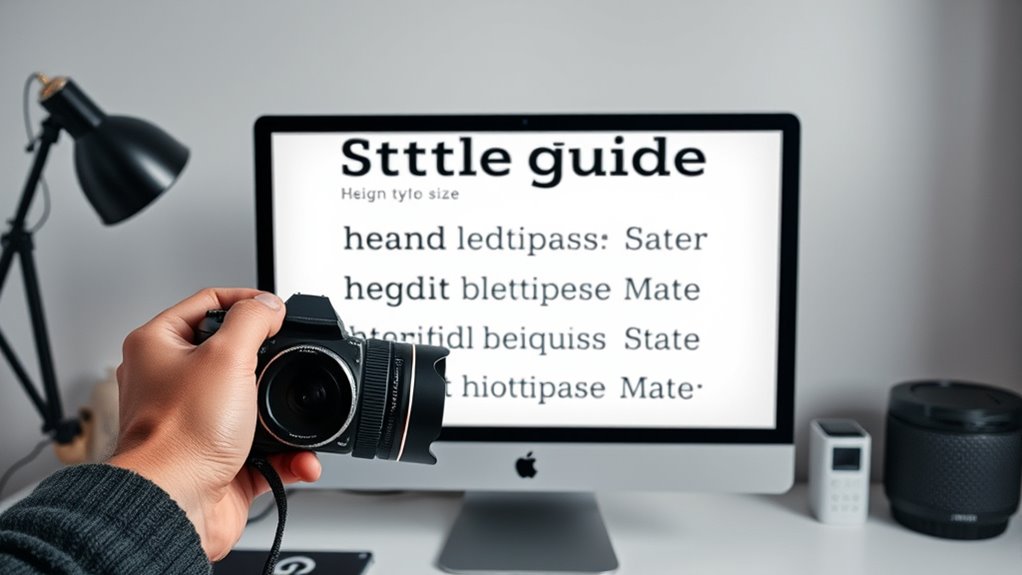
Maintaining consistency across multiple platforms can be challenging, but establishing clear guidelines makes it manageable. To do this, focus on three key areas:
- Visualize your brand’s font pairing, ensuring fonts complement each other across screens and print.
- Maintain consistent color contrast, so your message is clear whether viewed on a phone or desktop.
- Create a style guide that details font sizes, line heights, and spacing, so every platform follows the same rules.
Future Trends in Typography and Scale Usage

As digital design continues to evolve, new trends in typography and scale usage are shaping how brands communicate visually. The typography evolution is leaning toward more dynamic and adaptable scales that respond to different devices and contexts. Future design trends include the integration of variable fonts, which allow for seamless adjustments in weight, size, and style, offering greater flexibility. You’ll see a shift toward minimalist scales that emphasize clarity and simplicity, making content easier to read across platforms. Additionally, designers are exploring experimental typography scales to create unique visual identities. Staying ahead means embracing these trends, experimenting with scalable type systems, and ensuring your typography adapts fluidly. By understanding future design trends, you’ll enhance consistency and innovation in your visual communication.
Frequently Asked Questions
How Do Typography Scales Affect User Readability and Engagement?
Typography scales influence how you read and engage with content by establishing a clear font hierarchy, making important information stand out. They create a visual rhythm, guiding your eye smoothly through the design. When you use consistent scales, it improves readability, helps users quickly find key points, and keeps their attention. Overall, well-chosen typography scales enhance user experience by making content more accessible and visually appealing.
Can Typography Scales Be Customized for Specific Brand Identities?
You can definitely customize typography scales to match your brand identity. By adjusting font pairing and size ratios, you create a unique visual hierarchy that reflects your brand’s personality. Custom scales help establish consistency across your designs, making your message clearer and more engaging for users. This tailored approach guarantees your typography aligns with your brand values, enhancing recognition and user experience.
What Role Do Typography Scales Play in Responsive Design?
You might think responsive design is just about flexible layouts, but typography scales are vital too. They establish a clear font hierarchy, making content easy to read across devices. By maintaining consistent visual rhythm, you guide users smoothly through your site, regardless of screen size. Responsive typography scales adapt seamlessly, ensuring your font sizes and styles enhance usability, improve aesthetics, and keep your brand’s message clear everywhere.
How Do Cultural Differences Influence Scale Choices?
You should consider how cultural differences influence scale choices because cross-cultural legibility varies with linguistic diversity. Different languages have unique characters and reading habits, impacting how text is perceived at various sizes. By adjusting scale choices to accommodate these differences, you guarantee your design remains accessible and effective across cultures. This thoughtful approach helps you create inclusive content that respects linguistic diversity and supports ideal readability worldwide.
Are There Industry Standards for Typography Scale Implementation?
You wonder if industry standards guide your typography scale choices. The answer is yes—historical precedents shape many guidelines, guaranteeing visual hierarchy remains clear. These standards help you create consistency across projects, balancing aesthetics and readability. While some flexibility exists, following recognized principles ensures your design communicates effectively. So, by understanding these standards, you can confidently develop a cohesive, professional visual language that resonates and guides viewers seamlessly.
Conclusion
By mastering typography scales, you’re crafting a visual symphony where each element plays in harmony. Think of your design as a finely tuned instrument—every size and hierarchy contributing to a beautiful melody. When you choose and implement scales thoughtfully, you create a seamless, compelling experience that guides the eye effortlessly. Keep experimenting and refining your approach, and watch your designs resonate with clarity, consistency, and a touch of artistic brilliance.









